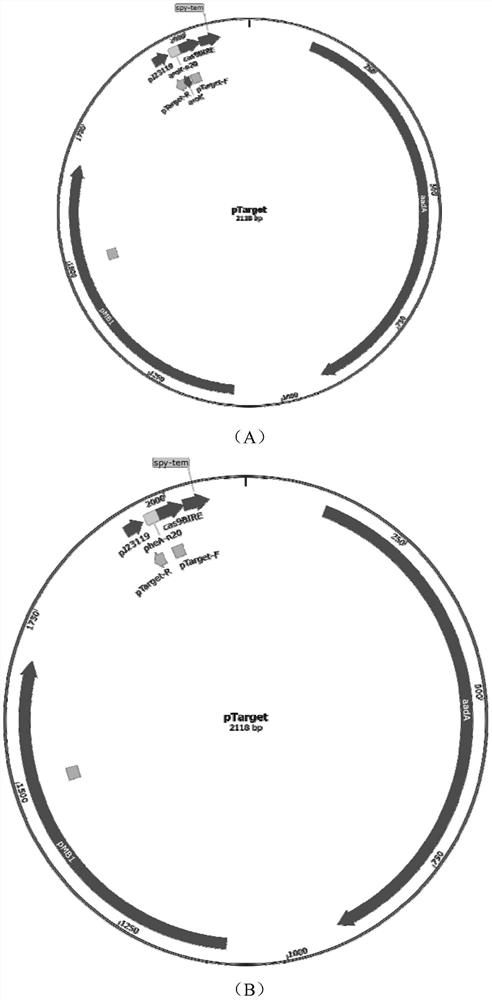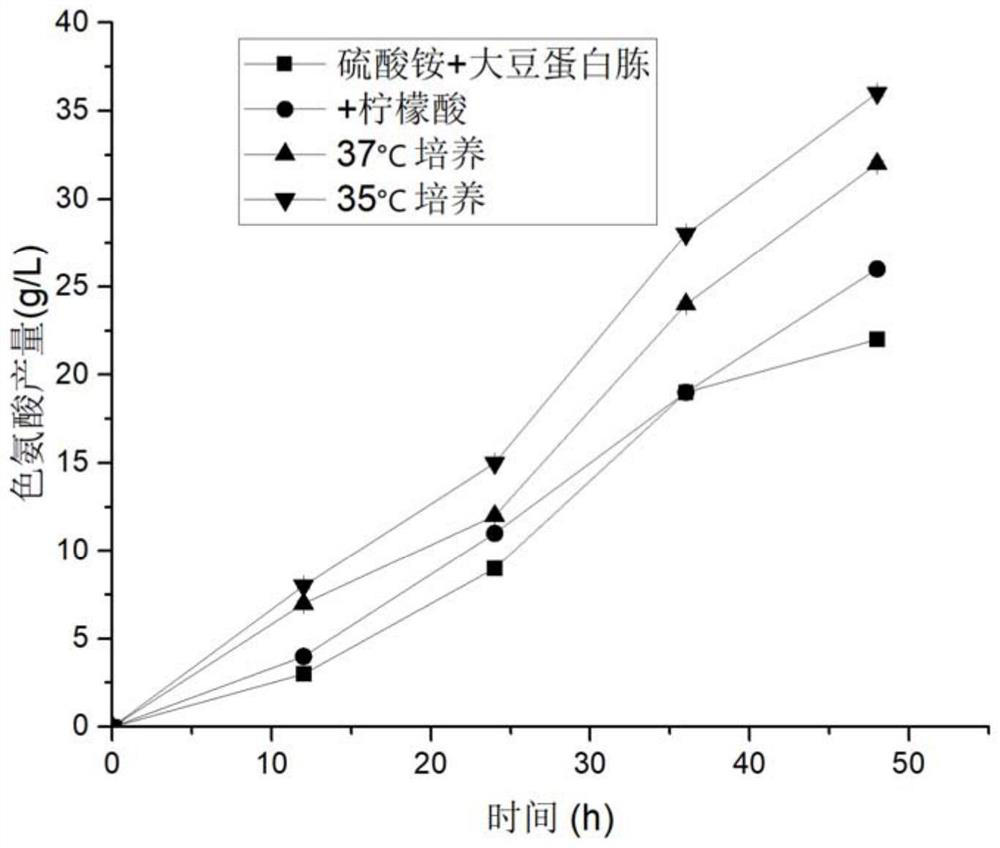A kind of recombinant Escherichia coli with high production of l-tryptophan and its construction method
A technology for recombining Escherichia coli and Escherichia coli, which is applied in the field of genetic engineering, can solve problems such as doubts about the use of antibiotics, and achieve the effect of simple construction method, good application prospects, and easy use
- Summary
- Abstract
- Description
- Claims
- Application Information
AI Technical Summary
Problems solved by technology
Method used
Image
Examples
Embodiment 1
[0048] Construction of embodiment 1 recombinant fragment
[0049] According to the Escherichia coli genome sequence information, design primers pT-aroK-1R and pT-aroK-2F, pT-aroK-1F, pT-aroK-2R (see Table 1), use the above four primers from the Escherichia coli CICC 10303 genome Amplify 600 bp of the homologous arm gene sequence of the aroK gene with the T7 promoter, and fuse the obtained two amplified fragments by fusion PCR technology to obtain the recombinant fragment T7AROK;
[0050] According to the genome sequence information of Escherichia coli, primers pT-pheA-1F, pT-pheA-1R, pT-pheA-2F and pT-pheA-2R were designed to amplify the start codon of pheA gene from the genome of Escherichia coli CICC 10303 The homologous arm gene sequences on both sides of the gene were 600 bp, and the obtained two amplified fragments were fused by fusion PCR technology to obtain the recombinant fragment TACPHE.
[0051] According to the Escherichia coli genome sequence information, design ...
Embodiment 2
[0054] The construction of embodiment 2 recombinant plasmids
[0055] According to the vector pTarget sequence information, design primers pT-aroK-F, pT-aroK-R, and perform PCR to obtain the linearized vector pTT7A containing sgRNA (sequence information is shown in SEQ ID NO.5); design primer pT-pheA-F , pT-pheA-R, carry out PCR to obtain the linearized carrier pTPH containing sgRNA (sequence information is shown in SEQ ID NO.6); design primers pT-mtr-F, pT-mtr-R, carry out PCR to obtain the linearized carrier containing The pTMT of the sgRNA (sequence information is shown in SEQ ID NO.7), pTT7A, pTPH, and pTMT were respectively connected with the recombinant fragments T7AROK, TACPHE, and MTRD to construct a recombinant plasmid, and the BamHI and BsgI double enzyme digestion verification and sequencing confirmed the successful construction of the recombinant plasmid . Plasmid maps of pTT7A, pTPH, pTMT such as figure 1 shown.
Embodiment 3
[0056] Example 3 Construction of Recombinant T7AROK Fragment Escherichia coli
[0057] The pCas9 plasmid containing the cas9 protein was transformed into Escherichia coli CICC 10303. The Kana resistance plate was used to screen the successfully transformed recombinant Escherichia coli CICC 10303-cas9, and then the recombinant plasmid pTargetT7AROK was transformed into Escherichia coli CICC 10303-cas9, and the screening confirmed the successful integration of the T7 promoter, and 0.05mM IPTG was added to induce it at 30°C for 12 hours, and then removed For the recombinant plasmid pTargetT7AROK, primers pT-aroK-2F and pT-aroK-2R were used to select transformants for colony PCR, and a band of about 600 bp appeared. After the sequence was correct, the recombinant Escherichia coli CICC 10303-aroKT with aroK gene promoter T7 was obtained.
PUM
 Login to View More
Login to View More Abstract
Description
Claims
Application Information
 Login to View More
Login to View More - R&D
- Intellectual Property
- Life Sciences
- Materials
- Tech Scout
- Unparalleled Data Quality
- Higher Quality Content
- 60% Fewer Hallucinations
Browse by: Latest US Patents, China's latest patents, Technical Efficacy Thesaurus, Application Domain, Technology Topic, Popular Technical Reports.
© 2025 PatSnap. All rights reserved.Legal|Privacy policy|Modern Slavery Act Transparency Statement|Sitemap|About US| Contact US: help@patsnap.com



